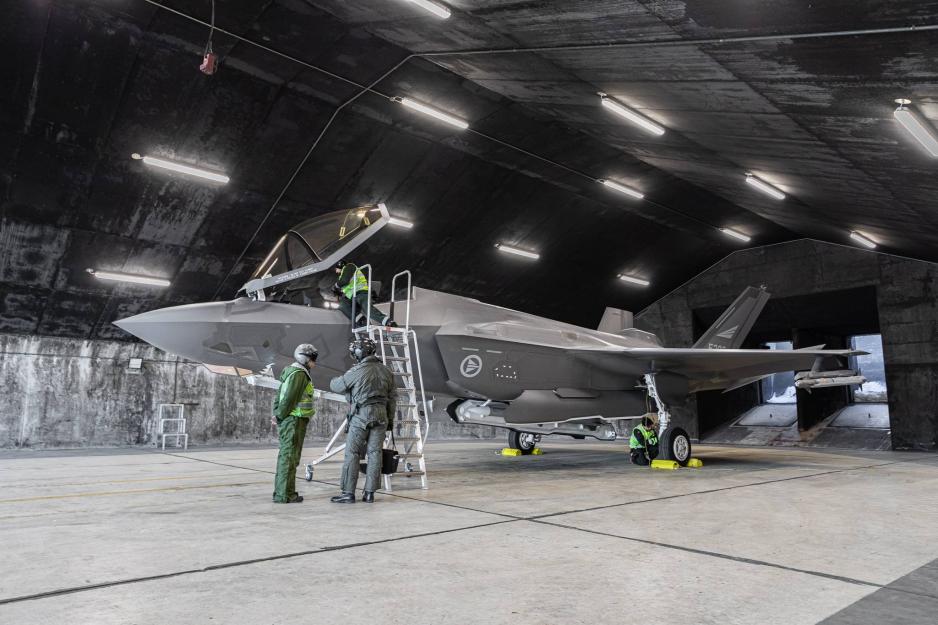Op-ed: Our High North Neighbor, Iceland

A Norwegian F-35 fighter at the Keflavik Air Station on Iceland during the mission "Iceland Air Policing" last year. (Photo: Ole Andreas Vekve/the Norwegian Armed Forces)
The Battle of the Atlantic would never have been won without the support of the people of Iceland, writes US Army Veteran Mike Thornton in this op-ed. He takes a historical look at Iceland and its strategic position.
This is an opinion piece written by an external contributor. All views expressed are the writer's own.
After being settled by the Vikings, Iceland formed one of the first parliaments in Europe in 930. The Kalmar Union (1397 to 1523) brought together Denmark, Sweden, Norway, Iceland, Greenland, and the Faroe Islands. After the dissolution of the Kalmar Union, Iceland fell under the rule of Denmark.
Iceland declared itself a separate Kingdom at the end of World War I. However, Iceland continued to share the Danish Monarchy and be closely associated with Denmark. The outbreak of World War II created a dilemma for the island nation and all concerned.
Denmark and Norway were invaded on 9 April 1940, and the occupation of Denmark resulted in much concern. Could this mean that Iceland would suffer the fate of other Nordic countries under Nazi rule?
Iceland was invaded twice during World War II. Why did this happen, and what were the results of the Allied war effort?
Preventing Nazi occupation of Iceland
On 6 May 1940, Winston Churchill briefs the war cabinet that he is sending a force to Iceland to prevent the Nazi occupation of the island. A few days later, the Germans launched an assault on the low counties, and war is now raging on the continent.
British Prime Minister Chamberlin resigned on 10 May 1940, leaving Churchill as Prime Minister and the Minister of Defense. On that same day, 756 British Royal Marines landed, beginning the first “invasion” of Iceland.
The Icelandic people may not have appreciated the reason this was happening. After all, they were a neutral country. Warfare was raging first in Norway and Denmark and now on the continent of Europe. The normal diplomatic process had certainly broken down due to the fog of war.
It did not reassure the Icelanders that many of the Marines, there to protect them, were new to the service and completely untrained. The newly arrived troops did not make a good impression. These were not the highly professional Corps of Royal Marines we would see later in the war and today.
A series of events will unfold in the early years of World War II that are going to directly affect the defense of Iceland.
British forces are going to be stretched to the breaking point first in North Africa, then Greece, and finally on the island of Crete. Hitler had a nasty habit of reinforcing his Italian allies causing the British war leader great concern.
A series of events will unfold in the early years of World War II that are going to directly affect the defense of Iceland.
It is now May 1941, and the British stand alone against the might of the Axis empire. They are in a desperate situation. Britain must have help.
Churchill asked American President Franklin Roosevelt, "Can you send troops to North Africa?" The president’s reply is unprintable, but it was something like this: "No, Winston, I can’t. We are not at war with anyone."
Troops to Iceland
Churchill in desperation, asked Roosevelt to send troops to Iceland so he could move his troops where they were desperately needed.
Roosevelt tells General Marshall, Army Chief of Staff, to send troops to Iceland. Sir, Marshall may have said, "Remember when Congress passed the draft last year? They specifically prohibited drafted troops from serving outside the United States. The solution: send the United States Marines."
The American President can only go so far. He told Churchill that he would only send troops to Iceland if the government there invited the United States to garrison the island. The morning of 7 July 1941 dawned with American Marines offshore but with no invitation. The matter was resolved, and the Marines landed.
The Battle of the Atlantic would never have been won without the support of the people of Iceland.
Again, not all Icelanders were happy about this “second invasion” of allied troops. But several things have changed. The Nazis were winning the Battle of the Atlantic. Allied convoys had to get to England, and the Nazi U-boat threat was a serious impediment to the war effort and Britain’s survival.
The U.S. Navy established an air station as early as August 1941. This allowed air cover to help close the “mid-Atlantic air gap” that the Germans were using to decimate Allied convoys.
The harbor was vastly improved, and roads, hospitals, and other facilities were built. Construction was omnipresent, and Iceland's economy was growing to meet wartime demand.
Merchant and Navy ships could travel a short distance to Iceland from the North Atlantic route for repairs or fuel and weapons replenishment. Iceland became a waystation and a godsend to mariners and airmen alike; in need of help and crossing the freezing and hostile North Atlantic.
The Battle of the Atlantic would never have been won without the support of the people of Iceland.
The Icelandic friendship
On 17 June 1944, Iceland became an independent Republic. Iceland would become a charter member of NATO. Patrolling the Greenland, Iceland, and UK gap became critical in keeping track of the Soviet Submarine fleet during the Cold War.
Today, Iceland has a modern Coast Guard that patrols the island and monitors its airspace. Ships from NATO Navies still patrol the North Atlantic, and many of the Nordic Air Forces patrol the skies over Iceland. Because of its strategic location, the island nation remains critical in maintaining security for the High North.
Once Norwegian merchant mariners found a friendly port for repairs or medical aid. Today, the Norwegian Air Force receives the same warm welcome when visiting. Iceland and its people have proven their friendship since the beginning.

